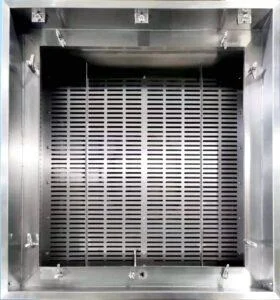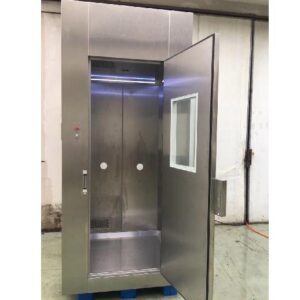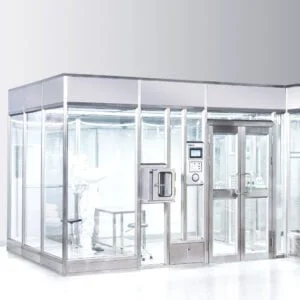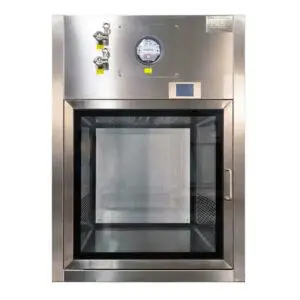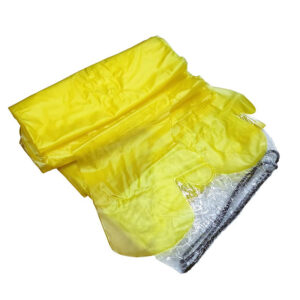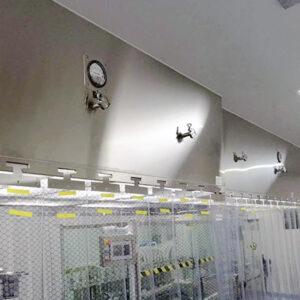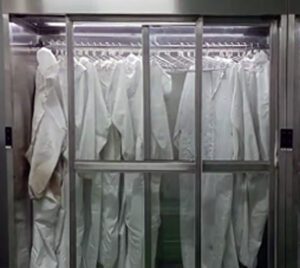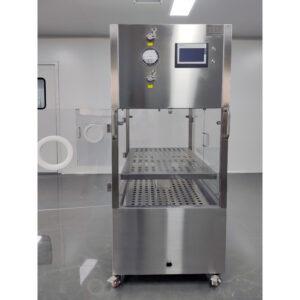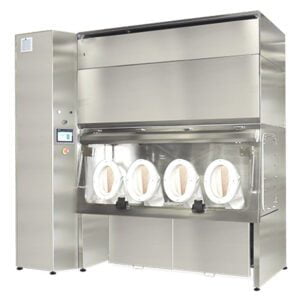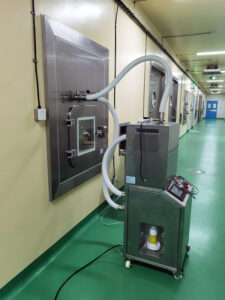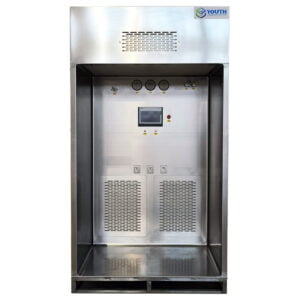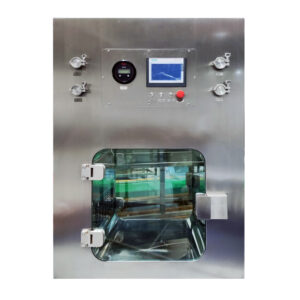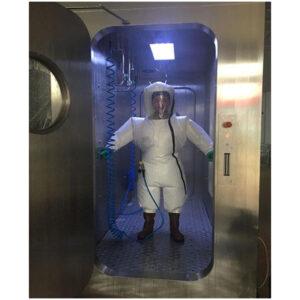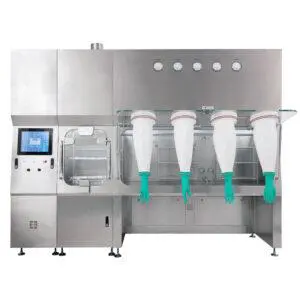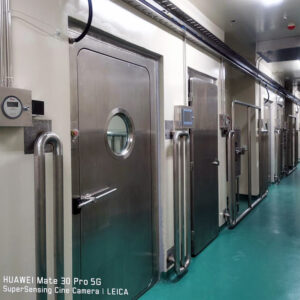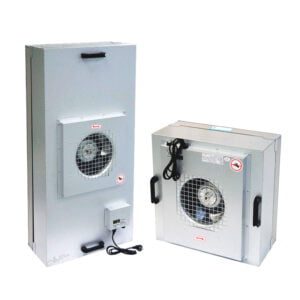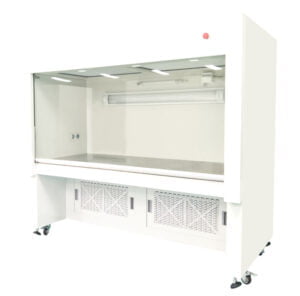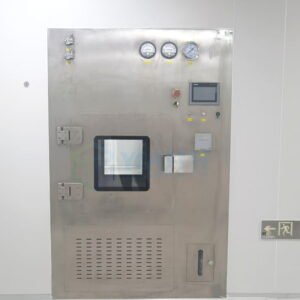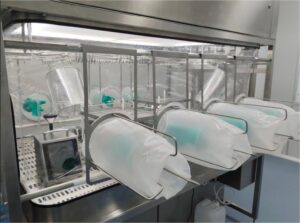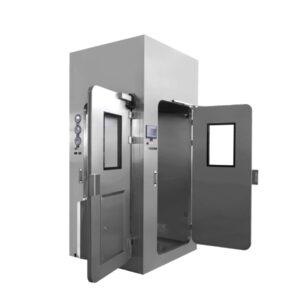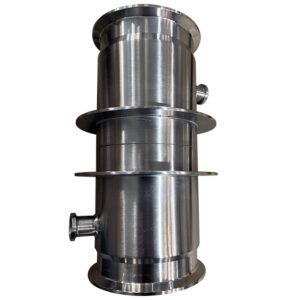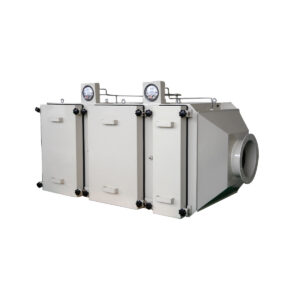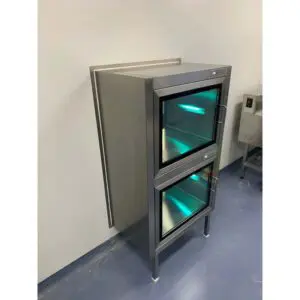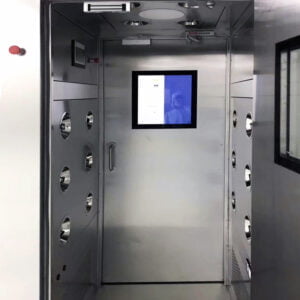Chemical shower rooms are a critical component of many laboratory and industrial settings, ensuring the safety and well-being of workers who may come into contact with hazardous materials. However, it's equally important that these facilities are accessible to all individuals, including those with disabilities. This is where ADA compliance comes into play, ensuring that chemical shower rooms are designed and constructed to accommodate everyone who might need to use them.
The Americans with Disabilities Act (ADA) sets forth specific guidelines for the design and construction of accessible facilities, including chemical shower rooms. These regulations are intended to ensure that individuals with disabilities have equal access to safety equipment and can use it effectively in emergency situations. Compliance with these standards is not only a legal requirement but also a moral imperative, promoting inclusivity and safety for all employees and visitors in environments where chemical exposure risks are present.
As we delve deeper into the world of ADA compliant chemical shower rooms, we'll explore the key design elements, safety features, and regulatory requirements that make these facilities both functional and accessible. From spatial considerations to the placement of controls and grab bars, every aspect of these rooms must be carefully planned to meet ADA standards while still fulfilling their primary purpose of emergency decontamination.
ADA compliant chemical shower rooms are essential safety features in laboratories and industrial settings, designed to provide quick and effective decontamination for all individuals, regardless of physical ability, in the event of chemical exposure.
What are the key spatial requirements for ADA compliant chemical shower rooms?
When designing ADA compliant chemical shower rooms, one of the most critical aspects to consider is the spatial layout. These rooms must provide enough space for individuals using mobility devices to maneuver safely and effectively, while also accommodating the necessary emergency equipment.
The ADA guidelines specify minimum dimensions and clear floor space requirements to ensure accessibility. For instance, a typical ADA compliant chemical shower room should have a clear floor space of at least 60 inches in diameter to allow for a full 360-degree turn of a wheelchair. This unobstructed area is crucial for easy access and exit in emergency situations.
Beyond the basic dimensions, the layout must also account for the placement of shower heads, controls, and safety equipment. These elements should be within reach of individuals seated in wheelchairs or those with limited mobility. The shower area itself typically requires a minimum of 36 inches by 36 inches of clear space, with no curb or a maximum threshold height of 1/2 inch to allow for easy wheelchair access.
ADA standards mandate that chemical shower rooms have a minimum clear floor space of 60 inches in diameter, with shower areas measuring at least 36 inches by 36 inches, to accommodate wheelchair users and ensure safe maneuverability during emergencies.
Here's a small table summarizing the key spatial requirements:
| Element | Minimum Requirement |
|---|---|
| Clear Floor Space | 60 inches diameter |
| Shower Area | 36 x 36 inches |
| Doorway Width | 32 inches |
| Maximum Threshold Height | 1/2 inch |
In conclusion, the spatial requirements for ADA compliant chemical shower rooms are designed to ensure that all individuals, regardless of their physical abilities, can access and use these crucial safety features effectively. By adhering to these guidelines, facilities can create inclusive and safe environments for all employees and visitors.
How should controls and accessories be positioned in ADA compliant shower rooms?
The positioning of controls and accessories in ADA compliant chemical shower rooms is crucial for ensuring that these facilities are usable by individuals with various physical abilities. Proper placement not only enhances accessibility but also contributes to the overall safety and efficiency of the shower room in emergency situations.
According to ADA guidelines, all controls, including faucets, shower heads, and emergency shut-off valves, should be operable with one hand and not require tight grasping, pinching, or twisting of the wrist. This requirement ensures that individuals with limited hand dexterity can easily activate and operate the shower.
The height of controls is another critical factor. Typically, controls should be mounted between 38 inches and 48 inches above the floor. This range allows for easy reach by both standing individuals and those using wheelchairs. Additionally, controls should be located on the wall adjacent to the shower seat, not on the back wall, to prevent users from having to reach across their bodies to operate the shower.
ADA standards require that all controls in chemical shower rooms be operable with one hand, without the need for tight grasping or twisting, and be mounted at a height between 38 and 48 inches above the floor for easy access by all users.
Here's a table summarizing the key requirements for controls and accessories:
| Element | Requirement |
|---|---|
| Control Operation | One-handed, no tight grasping |
| Control Height | 38-48 inches above floor |
| Shower Head | Handheld with 59-inch hose |
| Grab Bars | 33-36 inches high, on back and side walls |
Accessories such as soap dishes, shampoo holders, and towel bars should also be placed within this accessible range. Grab bars are another essential accessory in ADA compliant shower rooms. They should be installed on the back wall and at least one side wall, mounted between 33 and 36 inches above the floor. These bars provide crucial support for individuals transferring from wheelchairs or those who need assistance with balance.
In conclusion, the thoughtful positioning of controls and accessories in ADA compliant chemical shower rooms is essential for creating a safe and accessible environment. By following these guidelines, facilities can ensure that their emergency decontamination equipment is usable by all individuals, promoting safety and inclusivity in the workplace.
What are the specific requirements for shower seats in ADA compliant chemical shower rooms?
Shower seats are a critical component of ADA compliant chemical shower rooms, providing necessary support and comfort for individuals who may have difficulty standing for extended periods or those who use wheelchairs. The proper design and installation of these seats can significantly enhance the usability and safety of the shower room.
According to ADA guidelines, shower seats in chemical shower rooms must be sturdy, stable, and securely attached to the wall. They should be able to support a minimum weight of 250 pounds, ensuring they can accommodate a wide range of users. The seat surface should be smooth, non-slip, and free from sharp or abrasive edges to prevent injury.
The dimensions and placement of the shower seat are also specified in ADA regulations. The seat should be L-shaped and extend the full depth of the stall, from the back wall to the shower opening. It should be 17-19 inches high and have a depth of 15-16 inches. The seat must be positioned on the wall opposite the controls, allowing easy access to the shower head and faucets.
ADA standards require shower seats in chemical shower rooms to support at least 250 pounds, be L-shaped with specific dimensions, and be positioned on the wall opposite the controls for easy access and maneuverability.
Here's a table summarizing the key requirements for shower seats:
| Element | Requirement |
|---|---|
| Weight Capacity | Minimum 250 pounds |
| Height | 17-19 inches |
| Depth | 15-16 inches |
| Shape | L-shaped, extending full stall depth |
| Surface | Smooth, non-slip |
It's important to note that the area beneath the seat should be free from obstructions to allow for proper drainage and easy cleaning. Additionally, the seat should fold up when not in use to provide more space for standing users or those who prefer to use their own mobility devices.
In conclusion, shower seats in ADA compliant chemical shower rooms play a vital role in ensuring accessibility and safety for all users. By adhering to these specific requirements, facilities can create inclusive environments that cater to the needs of diverse individuals, enhancing overall safety and usability in emergency situations.
How does proper lighting contribute to the accessibility of chemical shower rooms?
Proper lighting is a crucial yet often overlooked aspect of ADA compliant chemical shower rooms. Adequate illumination not only enhances the overall safety of the facility but also plays a significant role in making the space more accessible and user-friendly for individuals with visual impairments or low vision.
In chemical shower rooms, lighting serves multiple purposes. It helps users locate and operate controls, identify potential hazards, and navigate the space safely. ADA guidelines recommend that lighting in these facilities should be uniform and free from glare. The illumination level should be sufficient to allow for easy reading of signs and labels, as well as clear visibility of all fixtures and controls.
While the ADA doesn't specify exact light levels for shower rooms, industry standards suggest a minimum of 30 foot-candles (fc) of illumination at floor level. This level of lighting ensures that the space is well-lit without creating harsh shadows or reflections that could impair visibility. It's also important to consider the color temperature of the lighting, with cooler temperatures (around 4000K-5000K) generally providing better visibility and contrast.
Proper lighting in ADA compliant chemical shower rooms should provide uniform illumination of at least 30 foot-candles at floor level, with cool color temperatures to enhance visibility and contrast, ensuring safe navigation and operation for all users.
Here's a table summarizing key lighting considerations:
| Element | Recommendation |
|---|---|
| Minimum Illumination | 30 foot-candles at floor level |
| Color Temperature | 4000K-5000K |
| Uniformity | Even distribution, minimal shadows |
| Glare | Minimized or eliminated |
In addition to general lighting, task lighting near controls and safety equipment can further enhance accessibility. These focused light sources can help draw attention to important features and make them easier to locate and operate in emergency situations.
In conclusion, proper lighting is an essential component of ADA compliant chemical shower rooms. It contributes significantly to the overall accessibility and safety of the facility, ensuring that all users, regardless of their visual abilities, can effectively use the shower room when needed. By implementing thoughtful lighting design, facilities can create a more inclusive and secure environment for all employees and visitors.
What are the essential safety features required in ADA compliant chemical shower rooms?
ADA compliant chemical shower rooms must incorporate a range of safety features to ensure they can effectively serve their primary purpose of emergency decontamination while remaining accessible to all users. These safety features are designed to protect individuals from chemical exposure and provide immediate assistance in case of an accident.
One of the most critical safety features is the emergency eyewash station. This should be easily accessible and operable with a single motion, allowing for quick activation in case of eye contamination. The eyewash station should provide a gentle flow of tepid water for at least 15 minutes, as recommended by ANSI standards.
Another essential feature is the presence of clearly marked emergency shut-off valves. These should be easily identifiable and operable, allowing users or responders to quickly stop the flow of water if necessary. The shut-off valves should be positioned within reach of both standing individuals and those in wheelchairs.
ADA compliant chemical shower rooms must include easily accessible emergency eyewash stations, clearly marked shut-off valves, non-slip flooring, and proper ventilation to ensure the safety of all users during decontamination procedures.
Here's a table summarizing key safety features:
| Safety Feature | Requirement |
|---|---|
| Emergency Eyewash | Single-motion activation, 15-minute flow |
| Shut-off Valves | Clearly marked, easily accessible |
| Flooring | Non-slip, properly sloped for drainage |
| Ventilation | Adequate to remove chemical vapors |
Proper flooring is another crucial safety aspect. The floor should be non-slip, even when wet, to prevent falls during use. It should also be properly sloped towards a drain to ensure that contaminated water is quickly removed from the area.
Adequate ventilation is essential in chemical shower rooms to remove potentially harmful vapors and maintain air quality. The ventilation system should be designed to effectively exhaust contaminated air and introduce fresh air into the space.
In conclusion, the safety features in ADA compliant chemical shower rooms are designed to work in tandem with accessibility features, ensuring that all individuals can use the facility effectively and safely in emergency situations. By incorporating these essential elements, facilities can create a comprehensive safety system that protects all users, regardless of their physical abilities.
How do signage and labeling contribute to the accessibility of chemical shower rooms?
Signage and labeling play a crucial role in making chemical shower rooms accessible and user-friendly, especially in emergency situations where quick action is essential. Proper signage not only helps users locate and navigate the facility but also provides important instructions and safety information.
ADA guidelines specify requirements for signage to ensure it's readable and understandable by individuals with various disabilities. For chemical shower rooms, signs should be high-contrast and use large, sans-serif fonts for easy readability. Braille and raised characters should also be included to assist visually impaired users.
The placement of signs is equally important. Directional signs leading to the chemical shower room should be clearly visible from common areas and positioned at decision points along accessible routes. Within the shower room itself, signs should be placed at a consistent height, typically centered at 60 inches above the finished floor.
ADA compliant signage in chemical shower rooms must include high-contrast text, Braille, and raised characters, positioned at a consistent height of 60 inches above the floor, to ensure clear communication of critical information to all users.
Here's a table summarizing key signage requirements:
| Element | Requirement |
|---|---|
| Font | Large, sans-serif |
| Contrast | High contrast with background |
| Tactile Elements | Braille and raised characters |
| Mounting Height | Centered at 60 inches above floor |
| Content | Clear instructions and safety information |
Labeling of controls and safety equipment is another critical aspect. Each control, valve, and piece of safety equipment should be clearly labeled with its function. These labels should be easy to read and understand, using both text and universally recognized symbols where appropriate.
In conclusion, effective signage and labeling in ADA compliant chemical shower rooms are essential for ensuring that all users can quickly locate, understand, and operate the facility in emergency situations. By adhering to these guidelines, facilities can enhance the accessibility and safety of their chemical shower rooms, promoting a more inclusive and secure environment for all employees and visitors.
What considerations are necessary for the installation of ADA compliant chemical shower rooms in existing facilities?
Installing ADA compliant chemical shower rooms in existing facilities presents unique challenges that require careful planning and consideration. While new constructions can be designed from the ground up to meet ADA standards, retrofitting existing spaces often involves working within structural limitations and navigating potential obstacles.
One of the primary considerations is space allocation. ADA compliant chemical shower rooms typically require more floor space than traditional shower rooms to accommodate wheelchair users and provide the necessary clear floor space for maneuvering. This may necessitate the reconfiguration of adjacent areas or even the expansion of the existing space.
Another crucial factor is the plumbing infrastructure. Existing facilities may need significant plumbing modifications to accommodate the specific requirements of ADA compliant showers, such as hand-held shower heads with long hoses and precisely positioned controls. This can involve extensive work behind walls and under floors, which may impact the overall project timeline and cost.
Retrofitting existing facilities with ADA compliant chemical shower rooms often requires significant spatial reconfiguration, plumbing modifications, and potential structural changes to meet accessibility standards while maintaining the integrity of the building.
Here's a table summarizing key considerations for retrofitting:
| Consideration | Details |
|---|---|
| Space Allocation | May require expansion or reconfiguration |
| Plumbing Modifications | Extensive work may be necessary |
| Structural Changes | Potential reinforcement for grab bars |
| Flooring | May need replacement for proper slope and material |
| Lighting | Upgrades may be required for adequate illumination |
Structural modifications may also be necessary, particularly for the installation of grab bars and shower seats. These elements require solid anchoring points, which may not be present in existing walls. Reinforcement of wall structures might be required to ensure these safety features can support the required weight.
Flooring is another important consideration. Existing floors may need to be replaced or modified to provide the proper slope for drainage and to install non-slip surfaces that meet ADA standards. This can involve significant demolition and reconstruction work.
In conclusion, while installing ADA compliant chemical shower rooms in existing facilities can be challenging, it's a necessary step towards creating more inclusive and safe environments. By carefully considering these factors and working with experienced professionals, facilities can successfully retrofit their spaces to meet ADA standards and provide accessible emergency decontamination for all users.
How does regular maintenance contribute to the ongoing accessibility of chemical shower rooms?
Regular maintenance is a critical factor in ensuring the ongoing accessibility and functionality of ADA compliant chemical shower rooms. While proper design and installation are essential, without consistent upkeep, even the best-designed facilities can become inaccessible or unsafe over time.
Maintenance of ADA compliant chemical shower rooms involves several key areas. First and foremost is the regular inspection and testing of all components. This includes checking the operation of shower heads, controls, and safety features like emergency eyewash stations. These checks should be performed at least weekly to ensure that all elements are functioning correctly and are ready for use in case of an emergency.
Cleanliness is another crucial aspect of maintenance. Chemical shower rooms must be kept clean and free from debris to ensure they're safe and hygienic for all users. This includes regular cleaning of floors, walls, and fixtures, as well as ensuring that drains are clear and functioning properly.
Regular maintenance of ADA compliant chemical shower rooms, including weekly inspections, thorough cleaning, and prompt repairs, is essential for maintaining accessibility, ensuring safety, and extending the lifespan of these critical emergency facilities.
Here's a table summarizing key maintenance tasks:
| Maintenance Task | Frequency |
|---|---|
| Functional Checks | Weekly |
| Deep Cleaning | Monthly |
| Drain Inspection | Monthly |
| Grab Bar Stability Check | Quarterly |
| Signage Inspection | Quarterly |
Periodic checks of structural elements are also important. This includes verifying the stability of grab bars, shower seats, and other mounted accessories. Any signs of looseness or damage should be addressed immediately to prevent potential accidents.
Signage and labeling should also be regularly inspected to ensure they remain clear and legible. Faded or damaged signs should be promptly replaced to maintain clear communication of important information.
In conclusion, regular maintenance is not just about keeping chemical shower rooms clean and functional; it's about ensuring they remain accessible and safe for all potential users. By implementing a comprehensive maintenance program, facilities can protect their investment in ADA compliant infrastructure, extend the lifespan of these critical safety features, and maintain a high level of readiness for emergency situations.
In conclusion, ADA compliant chemical shower rooms are essential safety features in laboratories and industrial settings, designed to provide quick and effective decontamination for all individuals, regardless of physical ability. By adhering to ADA guidelines in their design, construction, and maintenance, facilities can ensure that these critical emergency resources are accessible and usable by everyone who might need them.
From spatial requirements and control positioning to safety features and signage, every aspect of an ADA compliant chemical shower room is carefully considered to maximize accessibility and functionality. The implementation of these standards not only meets legal requirements but also demonstrates a commitment to inclusivity and safety in the workplace.
Regular maintenance plays a crucial role in preserving the accessibility and effectiveness of these facilities over time. By conducting routine inspections, cleaning, and repairs, organizations can ensure that their chemical shower rooms remain ready for use in emergency situations, potentially saving lives and preventing serious injuries.
As we continue to strive for more inclusive and safe work environments, the importance of ADA compliant chemical shower rooms cannot be overstated. These facilities represent a fusion of safety technology and accessibility design, embodying the principle that emergency preparedness should extend to all individuals, regardless of their physical abilities.
By prioritizing the implementation and maintenance of ADA compliant chemical shower rooms, organizations not only protect their employees and visitors but also contribute to a broader culture of safety and inclusivity in the workplace. As technology and design continue to evolve, we can expect further innovations in this field, potentially leading to even more effective and accessible safety solutions in the future.
YOUTH is committed to advancing safety and accessibility in laboratory and industrial settings, recognizing the critical importance of ADA compliant chemical shower rooms in ensuring the well-being of all individuals in potentially hazardous environments.
External Resources
Chapter 6: Bathing Rooms – Access Board – This guide explains the ADA Standards for bathing rooms, including requirements for accessibility in new construction and alterations, and the need for compliant shower compartments or bathtubs.
ADA Showers – Handicapped Accessibility | Wheelchair Accessible – Provides detailed information on ADA compliant showers, including the sizes and specifications for transfer and roll-in showers, and the necessary accessories and features.
ADA Shower Requirements – Roll-in & Transfer Showers – Outlines the specific requirements for ADA compliant showers, such as threshold heights, clearances, and accessory configurations, including grab bars and shower seats.
ADA-Compliant Cleanroom Air Showers | CAP701KD-ST-7372 – Discusses the ADA compliance requirements for cleanroom air showers, including clear floor space, doorway width, control accessibility, and lighting.
ADA Compliance for Shower Rooms and Bathing Facilities – Offers a comprehensive overview of ADA compliance for shower rooms, including multi-user and unisex bathing rooms, and the specific features required for accessibility.
Designing ADA Compliant Shower Rooms – Provides guidance on designing shower rooms that meet ADA standards, focusing on spatial requirements, fixtures, and other essential elements.
ADA Guidelines for Bathing Facilities in Commercial Buildings – Explains the ADA guidelines for bathing facilities in commercial buildings, including the requirements for accessible showers, toilets, and lavatories.
Creating Accessible Shower Rooms: A Guide to ADA Compliance – A detailed guide for architects and builders on creating accessible shower rooms that comply with ADA standards, covering design principles and technical specifications.
Related Contents:
- Emergency Chemical Shower Rooms: Quick Response Guide
- Enclosed Chemical Shower Rooms: Privacy and Safety
- Stainless Steel Chemical Shower Rooms: Durability Guide
- Top 5 Portable Chemical Shower Rooms for Labs
- Laboratory Chemical Shower Rooms: Essential Features
- Outdoor Chemical Shower Rooms: Weather-Resistant Options
- Chemical Shower Room Safety: 10 Essential Protocols
- 2025 Guide: Combination Eye Wash and Shower Rooms
- Space-Efficient LAF Garment Cabinet Designs


